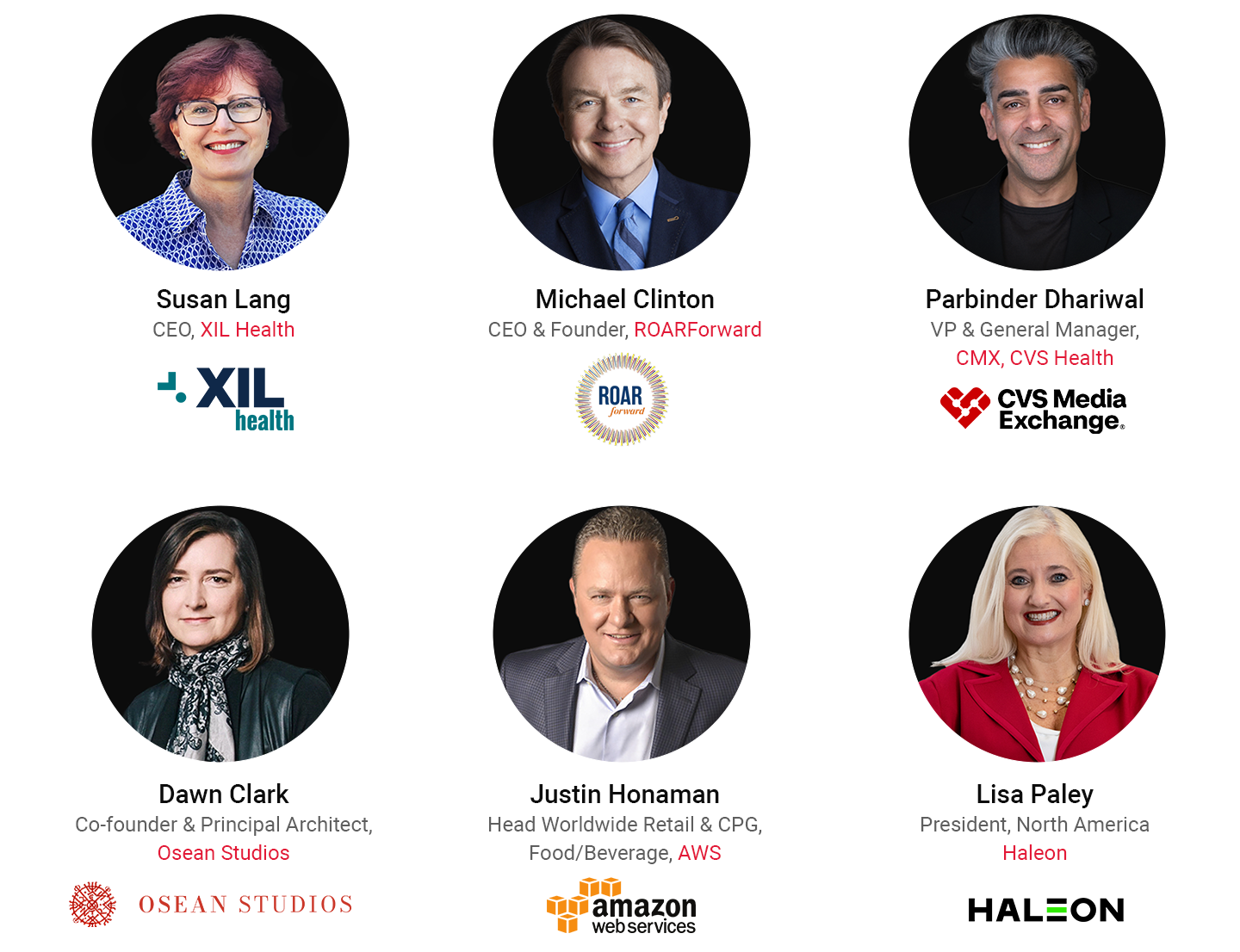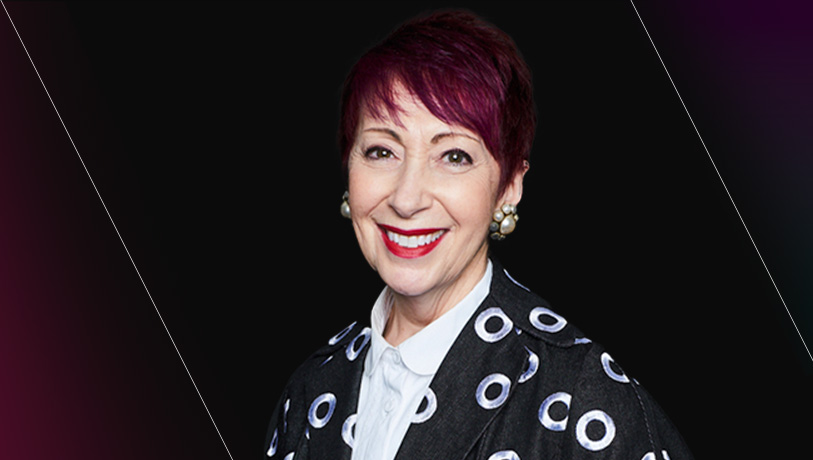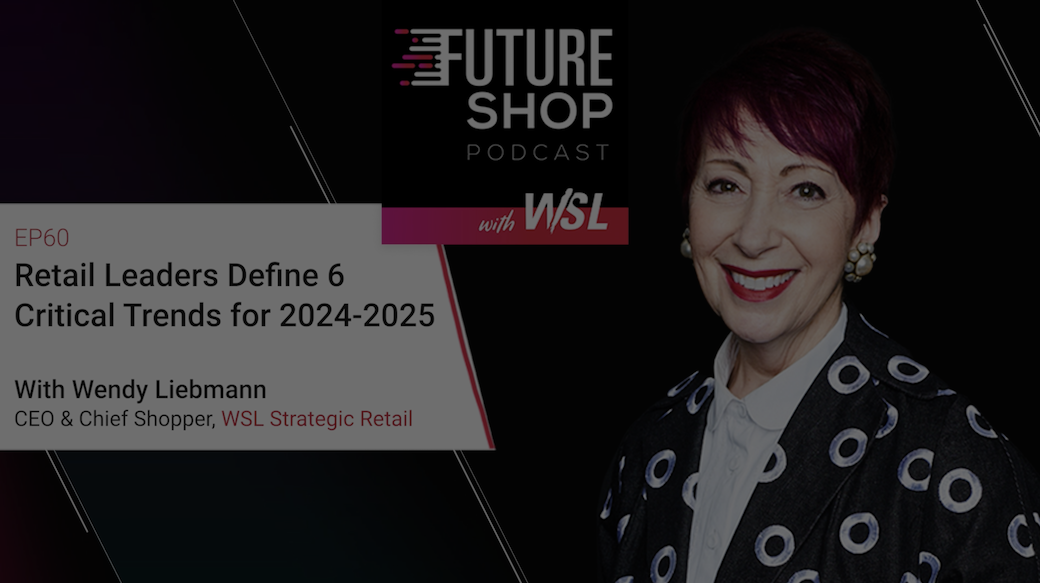In this episode:
Wendy Liebmann talks to six industry leaders about key trends that will impact retail in 2024-2025. Listen to:

They discuss:
- The health and wellness revolution at retail, and how to define women’s wellness.
- The new generation cohort driving growth: how 50+ consumers are the big opportunity now.
- Personalization, retail media, and how one-to-one marketing is finally in retail’s sights.
- The role of the physical store: now a place of engagement, not more stuff.
- How AI has already transformed business. Now what?
- The urgency to create a modern corporate culture; engaging internal and external constituencies to grow.
Don’t miss upcoming episodes, subscribe to our podcast with your favorite app.
Watch the video episode:
Wendy 00:09 Hello everyone, I'm Wendy Liebmann CEO and chief shopper WSL Strategic Retail and this is Future Shop. This is where I talk to innovators disruptors and iconic this about the future of retail. Wendy 00:29 In this episode, I'm going to talk not to one, but actually to six. Yes, six innovators, disruptors and iconic class. Why six? Well, as we're all getting ready and planning for the 2024, 2025, what's it all going to look like? I thought I would bring you the very best thinking from the best retailers, the best brand builders, health care experts, and retail architects that together will give you some really deep, great insight into what your plan should look like for the coming 12, 18, 24 months, and what the future of retail really needs to be for your future of retail. Hence, we're gonna have a party. So let's begin at the beginning. The first really big thing that we have been hearing in our retail and CPG world, literally the world is the impact women are having leading the health and wellness revolution. You've heard from us in all our latest How America Shops® research about what women expect, what they're burdened with, how they're the caregivers in the family. And the truth is, if we're thinking about everybody's health and wellness, it's all on her. My guest to talk about that is Susan Lang. She is the founder of XIL Health a women owned healthcare analytics and technology company, she invests in healthcare startups, she has spent her entire working life in the healthcare space, she has a really compelling interesting view about where healthcare is going, the role of retail healthcare, and the power that women have, let's have a listen to what Susan's got to say. Susan 02:18 So if you think of a retail store, I do think the whole front end of that store needs to be reimagined so that you could have potentially a smart store where you had a pod, I mean, if you think about this, you could go into a pod, you could rent the pod, you could pay a fee, you step in like you would an old photo booth, and you get your primary care visit is done. On screen, everything's monitor for you, including your blood pressure, you get your script, you walk out, you fill the script, and you're out and you've just had a primary care visit, I do think the front end of the stores from a product perspective has to start moving to service and beyond service has to start moving to data really is the product. People want their data and they want insights on their data. And they want to understand what data is being collected even on their wearable devices. Where's it going? And who's using it? And how does it benefit them. So I think that's a whole new challenge to start to think about. But I think it's actually really exciting. When you think about that women make 70% of all health care decisions in this country, which is also shocking women who are taking care of their kids, their family, their parents, or community and who aren't taking care of themselves. We really want to hear the voice of what women need at each stage of their life and how we put those supports in place. Can we do care packages through subscription? Okay, so you're having your first baby, what do you need to come every month that you haven't thought about to help you feel better? What you need to come for the 12 months after you have your first child? What do you need? If you're going through breast cancer? Do you have ice pops in your freezer? Because we know that chemo you know it's going to affect your mouth, all these different things that could be done so easily that you wouldn't have to learn yourself, every new person who gets sick. They're on this journey to discover what does it mean? What's the progression of that care? And what does that mean for them? Could we circumvent that somehow, and put those things in a store where they can come in and get them all in one place, you know, possibly in a package even delivered to them, which would be even better. Wendy 04:14 Susan tells a really extraordinary story. When you think about it. You know that whole vision of what a physical retail space could look like how to help woman as caregiver how to think about the arc of a woman's life. And all of the moments in that life where she is expecting looking for solutions for not only her own personal health and wellness, but then of her family and those she cares for. This isn't just about where we put it on this side of the store or that side of the store. This is about whole focus on the impact of health and wellness and the power of women and retail to lead in that space. So I'm sure you've got the message right. My second guest is actually talking a lot about not just women and gender, but actually whole next generation that are defining growth in this country. Now, it's not Gen Z, Michael Clinton, the former president and publishing director of Hearst Magazines, he remains an advisor to Hurst. And he set up a brand new company recently that built from a book he wrote in 2021, called ROARForward Into the Second Half of Your Life. Yes, the generation he's talking about is actually not Gen Z. It's actually older people, not just Americans, older people around the world, those heaven forbid, 50 Plus, who are really defining this new world of consumption, lifestyle, spending, and retail, let's hear what Michael has to say about this 50 plus population and how in fact, retailers are actually getting an F grade when it comes to serving the needs of this population today. Michael 06:03 But I think the big headline is that this is probably the biggest social movements of our lives in that the world, the developed world, in particular, is going through a massive, massive shift in terms of living longer, we'd like to use that phrase as opposed to getting older, because if you're 50, and healthy, there's a very good chance you're going to live to be 90. So the whole lifecycle of the second half of life is going to change dramatically for us personally, individually, but also for brands, companies retailers, because this group is redefining their 50s 60s 70s and beyond. And by the way, it affects everyone regardless of race, gender, politics, religion, because everyone is going to be in this cohort. So I wanted to put a spotlight on not only that, but the people who are really at the forefront of redefining this cohort, I call them the reimagine errs, and they are the people who are really very, very different than any generation that's ever lived on planet earth. We can start there, I would add that right now in the United States alone, 35% of the population is already 50, plus the millennials turned 50. In seven years, they have a spending power of 8.3 trillion a year, which will grow to 13 trillion. They're not brand loyal, they're not interested in same old, same old, they're blowing up all of the stereotypes, and their force. And they also, by the way, have all of the assets and all of the money. So they're a powerful cohort, I actually call them the new growth market for smart marketers, and smart retailers. So one thing is happening, which is really interesting is for the first time in history, you're gonna have five generations of people in the workplace. And getting input from all the various generations is the secret sauce for what will be successful brands, marketers and retailers moving forward. And that includes those 50 plus folks who have a lot of experience. In retail gets an F, because generally the representation of anyone in their advertising who was over 30, forget over 40 is hard to find. Wendy 08:15 You gave retail in its broadest sense, I assume an F? How do you think retailers whether it's mass or big boxes, whether it's specialty, luxury department stores, ecommerce, whatever in the brands of all the things that we cover, anywhere people shop? What are the things that they need to be thinking about here? Is that product? Is it imagery is that design of store? What does it mean? What should they be looking at? So they move up from operable F? Michael 08:43 I think it's all of the above. Yeah, give you an example. In the automotive industry. What's happening is the average age of the car buyer in America today is 60. And the number of drivers who are on the road are considerably aging and getting older. And so the design of automotive products, both the software and the hardware are changing dramatically. Being age agnostic is important. Having representation of people that are contemporary versions of them, not some the husband and wife walking into the sunset, or petting the cat or playing with the grandchild, how about mountain biking or doing something that is sort of a different kind of representation? And of course, also, you know, the way a store is merchandise to reflect that in terms of not segregating people out based on age. And you know, a lot of the drugstore chains when they're focusing on that cohort, it's all about medical and health. Well, they're consumers who are buying lots of other things in their stores. So they should be integrated into those messages as well. Wendy 09:49 So we've talked about women, we've talked about generational surprises. Then there's a whole other piece that we heard Parbinder Dhariwal awhile back about when he spoke about personalization, one to one. So Parbs, for those who don't know him as the VP and general manager of CMX, at CVS, Health, CVS, the healthcare retailer, and he and I talked a lot about this thing called retail media networks. What we really talked about though, was this as a vehicle to personalize shopping experiences. And I asked him the question about, are we now at that moment in time, when we really can create one to one shopper personalization? Listen to what he had to say, you know how shopper obsessed I am. So can we step back a little bit, it feels like we're starting to talk about more appropriately is personalization. And it just took me back years, when we started to talk about one to one marketing. I mean, is that this moment now, Parbinder 10:51 I think it's been closer than it's ever been in regards to sort of being this moment, as retail media networks evolve, the piece that we cannot lose sight of as, as we see this evolution of retail media networks is how do we add value to the consumer through their journey within retail. And what I mean by that is, if you think about the depth and the breadth, that we have, CVS Health, and CVS Pharmacy through just even the Loyalty Program, which is Extra Care, so Extra Care has, you know, 74 million plus consumers, we're able to talk to them and communicate with them, be it through a digital environment, or be it through the physical environment as well, we understand that consumer we understand how they shop, we understand when they show up, we understand how they basket build, we understand the categories, they're much more focused around within our ecosystem. And the personalization concept comes into effect in order to help that consumer discover more products, or see products that are much more contextually relevant. And that's the piece that retail media networks really need to double down on is providing discoverability and contextually level relevant products when a consumer is looking for products within those categories. And let me just give you one example real quickly, which is, you know, if you think about the consumer, I'm looking for a new shampoo with this hair, I consistently looking for a new shampoo. If you're looking for a new shampoo, and ice come to cbs.com. And I search for shampoo, I want results that are shampoos, I want you to show me new products within the category that I may not have thought about previously or that much more suited to my hair type. And that's the level of work from a contextual environment that we need to build. The personalization aspect comes as a layer over the top of that it's understanding how consumers are purchasing that shampoo that propensity to buy that shampoo. And also what are the products that they purchasing when they look to buy that shampoo? And then how do we then serve that customer messaging in order for them to really understand other products within the categories that they could also basket build specifically or think about or brand build for the next purchase for the next visit to CVS or other retail? We're trying to digitize an analog industry, retail has been traditionally analog, especially brick and mortar, heavy retailers, such as CVS, and we're driving that forward. And we're driving that forward with the consumer in mind through their health and wellness journey. And the way in which we can actually continue to have that consumer engage with us, not just from a product purchasing perspective, but also, as we talked about earlier on the podcast is how do we give them more information to understand how they can improve their health and wellness journey as a whole. And you've got to be able to be incredibly purpose driven around that. Wendy 14:03 That got me to that point of saying, well, but in all of that what is actually the role of the store? What is the role of the physical store in this new world where we've got lots of big themes changing? Lots of discussion about technology? What is the physical store mean now? Well, my guest Dawn Clark, a noted retail architect, most recently, she was design director at Amazon for the new Amazon Style concept out of California. Previous to that she was at Nordstrom, so very high end luxury, Starbucks around the world, so on lots of different street corners, as well as Harrods in London and lots of really amazing retail spaces. What was fascinating about what dawn had to talk about is this notion of the human store and how retail now needs to take on a different role when we think combat its purpose, and how it builds emotional connection. Here's what dawn had to say, you can't Dawn 15:05 step over these emotional factors because in the end, it's this emotional experience that is going to create a connection between whatever brand you are and what you're trying to sell, which we know like, we just have too many choices. And there's so many products. And you have to do something more than that Wendy 15:25 mean that transition from going to Nordstrom and the 57th Street store with a beautifully curved and lighted facade, and then the space and the light, which is really quite extraordinary, to going to creating a new concept for Amazon with the style store, talk a bit about that concept, and the transition to create that Dawn 15:48 my found my other human factors were equally as relevant, even maybe more so in this sort of inter weaving and translation between technology and physical experience at the same time. So to step back for a second and say Amazon style, was envisioned to be really the first Amazon store concept for men's women's and kids clothing. And we worked extremely hard to bring the sort of best store we could imagine to life that included the development of digital tools in parallel to this physical store design that would enable key experiences to improve them and to get after pain points, you know, that exist in this experience of shopping for clothing. My team was a fully integrated design team. So I had design technology, UX design, brand, design, store, design, all the development and the construction all together, which was quite amazing, because we had UX designers who had never done anything in a physical space and physical designers who didn't have experience with UX design, getting together in a lab. I think, when you walk into a store, and you do this, this is what you do when he is there's somebody care, did somebody show up and organize things are the people well trained are. I mean, I hate to say it too, and I don't mean to be unkind. But oftentimes, these basics are just not in place. And it's hard retail operations. It's every day, and visual merchandising definitely one of my more favorite topics, but like it is probably your biggest selling tool, other than your employees in space for almost any product type. Wendy 17:42 You know, it's always amazing to talk to Dawn because she talks about things that I don't hear anybody else talk about space, light, air, all of those things that when we're building, you know, rows and rows, thinking about product and product on product, we forget that actually the physical space is about showcasing yes products, but it's really about creating an emotional connection with shoppers. So the fifth big theme that I think we've all been talking about since chat GPT came into our brains of brainwaves about six or eight or nine months ago was, what the heck is this AI thing? And how is it impacting our businesses? And how do we need to think about that? Well, the best guest to talk about that was my guest, Justin Honaman who's the head of worldwide retail and consumer products and go to market at Amazon Web Services, where he is talking about and understanding the level of engagement of the physical store, and the impact that AI has in creating what he calls meaningful shopper experiences. Take a listen. Justin 18:51 Immersive is another buzzword for the year and parts of it are real. So in the definition of how I wrote about this, I talked about personalization. I talked about AR and VR, which are real. I talked about virtual stores virtual try-on, which there are some great examples of those out there. And 3d images is really taking new life now for E commerce shopping, even virtual stores for consumer goods brands, like you could have a store without having actual store where you could curate products for a consumer or a customer to buy. Okay, so all of those things I mentioned are real and evolving. And so what we have seen over the last 12 months is a real shift back into immersive experiences in store and online. Wendy 19:35 There are a couple of other things on my list. One is, you know, of course, the infamous AI chat GPT Justin 19:42 it's been amazing how fast that topic has run around the last couple of weeks, weeks. And so yeah, I think be interesting to see like early days and we're dealing with new and different technology that no one has really dealt with so or had to think about how to leverage And so the question is like on things like that, and even some of the other technologies we've talked about, like if you're a legacy or major retailer, how do you balance the new shiny object, but also potential value? capabilities with the fact that you're sitting on old ERP systems that are expensive to operate and build change? You know, how do you think about customer experience with some of the new these new personalization capabilities? And in the immersive capabilities, right? How do you think about that, when you are balancing that with some of the operational challenges of getting inventory and sourcing and whatnot. So definitely good to keep an eye on what's happening in the market. And then in what you're seeing is from the retailers that are doing it? Well, they are looking, they're investigating, they're experimenting, they're trying things that are days and weeks of testing versus months and years, I was just thinking, as we were talking only two plus years ago, the hot topic was stores that were going to be closing, how can we drive revenue, we're having to shift to all ecommerce because people aren't going to stores and oh, my gosh, and we were counting store closings, if you remember. And here we are. Stores are opening, not that they're open. But they're growing retailers are investing in experience and in store and online. E commerce is level above where it was pre COVID markets are still opening around the world that we are going to see impacts from. And so my only thought and when I talk to customers like make sure to be thinking about how do you first don't go back to the old way of siloed work. But also position yourself to have the flexibility to spin things up and down and try things pull back on things more quickly in the future. So give yourself some of the flexibility to operate differently, because you don't know what will be the next thing. That's the way I've been thinking about the go forward is it's great that we're celebrating a lot of growth and new experience things and innovation. It's just 100 Make sure to position yourself for flexibility in the future. Wendy 22:00 Justin is going to join us on Future Shop Podcast where we're going to do kind of an AI update every month or so. So hold on for that that will be coming soon as we move into the fall. So the last big theme in all of this, what do we need to do for our companies and cultures? How do we think about all the constituents that we have in our world in our ecosystem that we have to serve? The person who provided huge insight and help and guidance on that discussion was Lisa Paley. Lisa is the president of Haleon in North America formerly GSK consumer health. And as she sat down with a virtually a white paper to create the mantra and strategy and values for this new organization with her teams, she focused on the three C's, let her tell you what they are all about. What do you see as the critical elements of a modern organization today, Lisa P 23:00 You have to operate like a small company. That's what makes it modern, because that's what the colleagues and the consumers are wanting how they want to engage and what they're finding fulfilling. It's also about that mindset of being small, nimble, very entrepreneurial, and regardless of your size. So that's how you have to behave. That's about behavior. Having sort of that founders mentality is really valued at modern companies, they talk a lot about prioritizing what you want versus what you need. And we have a value, you know, and hailing, that's like, do what matters most, you're really trying to tell people we get that you're living in this very busy, complex world today. And you're going to have to continue to be hyper prioritized in order to be effective, you know, at the things that you're trying to accomplish. People who value the voice of the customer who value the voice of colleagues, those are really resonant in modern companies, because you really have to keep your finger on the pulse with them. So you have to be really in tune to that. And finally, I would say just those companies that are really astute at adapting to change, and understanding that, you know, the pace of change does change continues to accelerate that what you do about that, and how you free people up to move at that pace. So you don't want to be as over prescriptive, you want a little more policy, less laws, you know, like those kinds of things that allow people to respond at the pace of the change that they need to, it took a minute to perfect the purpose, we put that word humanity in at a time when this world probably never needed it more, you know, like it was so much going on. But ours is really rooted in that everyday health care, too. And that was really important. But when you wake up and you go, wow, like that gets to be our purpose, and you can feel good about living that purpose every day, and genuinely helping people. Wendy 24:45 Your use of the word humanity was so compelling to me for several reasons we had done I think some of your team were actually there, a summit that we called the Big Business of Well just before the pandemic and we have had an architect during Dawn Clark. Dawn was designing the new Nordstrom store on 57th Street and responsible for store redesign coming out of Starbucks and other very iconic retail brands. And she talked about building creating a human store. And it was this sense of human and humanity, Lisa P 25:22 I think the fundamental underlying insight that people are finding is that you have to treat the whole person in, you can't just take a context or because you celebrate it, or you sell one product. And I mean, that's not how they think about it, or experience that they think about it in the context of their whole person, their whole family their whole life. And so I think as you come up with the view over the consumers, and you incorporate that more genuinely, and authentically, I think you get to different outcomes. We've said, spend time finding partners who have similar values systems and who also want to make these differences. And then you start to amplify, right, your potential to make a big positive impact on it? How do we benefit that consumer and delight them through experiences? How do we partner with the retailers in the mix? Right? Because they're gonna go experience and get these services and product somewhere? And then is it right for colleagues, you know, do colleagues feel good about that work they're doing? Are they doing it in the ways that they can rest well at night, knowing they always can do the right thing, when you start to combine those things, but definitely grounding and what I call the three C's. And it's got to be about the consumer, the customer being a retailer, and then the colleagues. And when you get right for them, you are going to be really well on your way to doing something pretty special. Wendy 26:37 So there you have it, those sort of critical requirements of a modern organization. So that's a pretty impressive group, if I may say, and I always like to think about the company we keep here at WSL. And I think that was pretty good company. I hope you felt the same way. Just sort of to wrap it up based on what everybody talked to us about, think about this, first of all, all in their own ways, talked about keeping the shopper in your sights at the center of all you do, whether it's store design, whether it's personalization, all of those aspects that culture within your companies are understanding where the potential shoppers really are. The second they all talked about in their own ways was think about solutions, not just more product lined up shelf by shelf, store by store, and not just tech for tech sake, but how technology builds that level of engagement, that level of loyalty that ultimately builds return on investment. But first, it begins with engagement. They all talked about in their own ways, the role of women, and how women are actually leading the World of Wellness and shopping, and how we think about women still as caregivers for everybody. And when we think about how do we make solutions provide solutions for their lives, that becomes more and more critical. We talked about building emotional connection, one shopper at a time, one experience at a time, one easy, make it simple experience at a time, both through technology and experience. And as Lisa said, you know, it's about engaging all the constituents all the seas and building that culture of care. Wendy 28:21 So as we think about a strategy for 2024 and 25. It's not just an external strategy. It's an internal strategy that we need to deliver to be successful. So thanks to these amazing disruptors who join us on the podcast, their vision of the future of retail is clear, inspirational, gives you a roadmap that you can absolutely adopt, absorb, share within your organizations. And for the full recording of these podcasts, you know, go to Apple Spotify, anywhere you get your podcasts or go to our website at wslstrategicretail.com where you can find not just those but many tools and insights to guide you to 2024 and beyond. So, thank you for joining me and all my fabulous experts today. See you in the future.



















